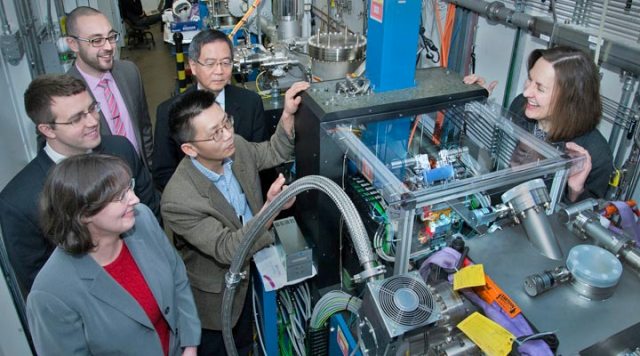Jan 9 2015
 Study collaborators Kevin Kirshenbaum (BNL), David Bock (SBU), Zhong Zhong (BNL), Kenneth Takeuchi (SBU), Amy Marschilok (SBU), and Esther Takeuchi (BNL & SBU) at the XPD beamline of the National Synchrotron Light Source II, where future experiments may build on this research.
Study collaborators Kevin Kirshenbaum (BNL), David Bock (SBU), Zhong Zhong (BNL), Kenneth Takeuchi (SBU), Amy Marschilok (SBU), and Esther Takeuchi (BNL & SBU) at the XPD beamline of the National Synchrotron Light Source II, where future experiments may build on this research.
Scientists at Stony Brook University and the U.S. Department of Energy's Brookhaven National Laboratory have successfully mapped internal atomic transformations using X-rays. This latest approach can help develop potential lithium-based batteries.
In a potential lithium-based battery, a highly conductive silver matrix is formed that changes a material which is otherwise afflicted by low conductivity. In order to enhance these multi-metallic batteries and also to improve the flow of electricity, researchers needed to find out how these silver nanoscale 'bridges' originate.
The scientists used x-rays in order to map this varying atomic structure and exposed its link to the discharge rate of the battery. This study demonstrates that when a slow discharge rate occurs early in the battery's life, it produces a more homogenous and extensive conductive network. This indicates novel design techniques and optimization methods.
At National Synchrotron Light Source (NSLS) of Brookhaven Lab, the researchers’ utilized intense and bright X-ray beams to explore lithium batteries equipped with silver vanadium diphosphate (Ag2VP2O8) electrodes. This cathode material had the required high voltage, high stability, and spontaneous matrix formation for the research, and may prove handy in implantable medical devices.
"Armed with this insight into battery cathode discharge processes, we can target new materials designed to address critical battery issues associated with power and efficiency. The experimental work—in particular the in-situ x-ray diffraction in batteries totally encased in stainless steel—should prove useful for industry as it can penetrate prototype and production-level batteries to track their structural evolution during operation," said Esther Takeuchi, Chief Scientist in Brookhaven Lab's Basic Energy Sciences Directorate and a SUNY Distinguished Professor at Stony Brook University.
As these batteries discharge, the lithium ions accumulated in the anode travel to the cathode and displace silver ions along the way. This displaced silver integrates with unused cathode material and free electrons to create the conductive silver metal matrix, and also serves as a medium for the obstructed electron flow.
"To visualize the cathode processes within the battery and watch the silver network take shape, we needed a very precise system with high-intensity x-rays capable of penetrating a steel battery casing. So we turned to NSLS," said Amy Marschilok study coauthor and Research Associate Professor at Stony Brook University.
At NSLS, energy dispersive x-ray diffraction (EDXRD) was able to give the real-time, in situ visualization data. In EDXRD, strong X-rays beams travelled via the specimen, losing energy as the beams were bent by the battery structure. Each individual set of detected beam angles, akin to time-lapse images, showed the changing chemistry as a virtue of battery discharge.
The silver forms in particles spanning less than 10 nanometers, and the diffraction patterns can be both dense and faint, said Zhong Zhong, a Brookhaven Lab scientist who carried out the key alignment for the x-ray studies at NSLS.
After the data was obtained, Kevin Kirshenbaum, a Brookhaven Lab postdoctoral researcher headed the data analysis effort. According to him, this kind of analysis and interpretation needs significant amount of time and knowledge, but the results can be dramatic.
In majority of batteries, the rate of discharge is determined by the speed of lithium-ion diffusion, a critical aspect in the overall efficiency and performance. Typically, the material nearest to the lithium anode would discharge first, since there is a shorter distance for the ions to travel. However, the scientists found that the material that was nearest to the coin cell surface and farthest from the anode discharged first in the battery.
"This is because the non-discharged cathode material is a very poor electric conductor, so the resistance for lithium ion diffusion is less than for electron flow. This highlights a uniquely efficient aspect of in situ silver matrix formation: The silver matrix forms primarily where needed, which is more efficient than using conductive additives," said coauthor and SUNY Distinguished Teaching Professor Kenneth Takeuchi.
The in situ diffraction results thus obtained were integrated with two methods, which were applied subsequent to operation. These methods included angle-resolved x-ray diffraction (XRD) and X-ray absorption spectroscopy (XAS).
By means of spectroscopy, precise chemistry can be observed. This is because each element emits and absorbs light distinctively; however, the X-rays utilized for XAS cannot pierce the battery casing. So following each step in the discharge, the cathode was removed and crushed into a powder to determine the average elemental composition.
These techniques provide complementary data: the in situ diffraction shows where the silver is formed within the cathode, while the spectroscopy shows more precisely how much silver was formed, Esther Takeuchi said.
NSLS’ 32-year experimental run was concluded in September 2014, but this work is being continued by the National Synchrotron Light Source II (NSLS-II) which provides beams that are 10,000 times brighter than that of NSLS. For NSLS-II, in situ energy research forms an important part of NSLS-II mission and will shortly welcome users from academia, industry, and other national labs.
We are currently working on other materials that form conductive networks and hope to study them as functioning cells. The brighter beams and greater spatial resolution of NSLS-II will be a great tool in studying other cathodes and pushing this technology forward, Takeuchid said.
The study has been published in the journal Science.